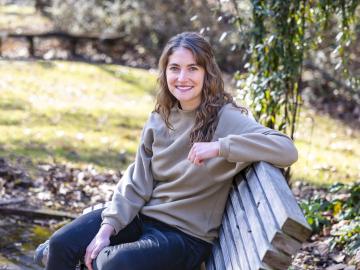Filter News
Area of Research
- Advanced Manufacturing (29)
- Biological Systems (16)
- Biology and Environment (116)
- Biology and Soft Matter (1)
- Building Technologies (10)
- Chemical and Engineering Materials (1)
- Chemistry and Physics at Interfaces (5)
- Clean Energy (397)
- Climate and Environmental Systems (6)
- Computational Biology (5)
- Computational Engineering (4)
- Computer Science (14)
- Data (1)
- Electricity and Smart Grid (1)
- Energy Frontier Research Centers (8)
- Energy Sciences (4)
- Fossil Energy (3)
- Fuel Cycle Science and Technology (1)
- Functional Materials for Energy (7)
- Fusion and Fission (28)
- Fusion Energy (10)
- Geographic Information Science and Technology (2)
- Isotope Development and Production (3)
- Isotopes (22)
- Materials (312)
- Materials Characterization (2)
- Materials for Computing (23)
- Materials Synthesis from Atoms to Systems (6)
- Materials Under Extremes (6)
- Mathematics (1)
- National Security (48)
- Neutron Data Analysis and Visualization (2)
- Neutron Science (120)
- Nuclear Science and Technology (47)
- Nuclear Systems Modeling, Simulation and Validation (3)
- Nuclear Systems Technology (1)
- Quantum Condensed Matter (1)
- Quantum information Science (4)
- Reactor Technology (1)
- Renewable Energy (3)
- Sensors and Controls (4)
- Supercomputing (157)
- Transportation Systems (7)
News Type
Date
News Topics
- 3-D Printing/Advanced Manufacturing (85)
- Advanced Reactors (25)
- Artificial Intelligence (44)
- Big Data (28)
- Bioenergy (55)
- Biology (59)
- Biomedical (36)
- Biotechnology (13)
- Buildings (38)
- Chemical Sciences (43)
- Clean Water (20)
- Climate Change (56)
- Composites (20)
- Computer Science (108)
- Coronavirus (34)
- Critical Materials (23)
- Cybersecurity (26)
- Decarbonization (38)
- Education (3)
- Element Discovery (1)
- Energy Storage (85)
- Environment (115)
- Exascale Computing (12)
- Fossil Energy (1)
- Frontier (17)
- Fusion (30)
- Grid (42)
- High-Performance Computing (45)
- Hydropower (8)
- Irradiation (2)
- Isotopes (29)
- ITER (6)
- Machine Learning (27)
- Materials (99)
- Materials Science (93)
- Mathematics (4)
- Mercury (9)
- Microscopy (36)
- Molten Salt (7)
- Nanotechnology (44)
- National Security (35)
- Net Zero (6)
- Neutron Science (84)
- Nuclear Energy (57)
- Partnerships (27)
- Physics (44)
- Polymers (25)
- Quantum Computing (14)
- Quantum Science (38)
- Renewable Energy (1)
- Security (18)
- Simulation (18)
- Space Exploration (13)
- Statistics (3)
- Summit (28)
- Sustainable Energy (86)
- Transformational Challenge Reactor (4)
- Transportation (71)
Media Contacts

ORNL’s Assaf Anyamba has spent his career using satellite images to determine where extreme weather may lead to vector-borne disease outbreaks. His work has helped the U.S. government better prepare for outbreaks that happen during periods of extended weather events such as El Niño and La Niña, climate patterns in the Pacific Ocean that can affect weather worldwide.

The Department of Energy’s Oak Ridge National Laboratory is providing national leadership in a new collaboration among five national laboratories to accelerate U.S. production of clean hydrogen fuel cells and electrolyzers.

Canan Karakaya, a R&D Staff member in the Chemical Process Scale-Up group at ORNL, was inspired to become a chemical engineer after she experienced a magical transformation that turned ammonia gas into ammonium nitrate, turning a liquid into white flakes gently floating through the air.
The United States could triple its current bioeconomy by producing more than 1 billion tons per year of plant-based biomass for renewable fuels, while meeting projected demands for food, feed, fiber, conventional forest products and exports, according to the DOE’s latest Billion-Ton Report led by ORNL.

In partnership with the National Cancer Institute, researchers from ORNL and Louisiana State University developed a long-sequenced AI transformer capable of processing millions of pathology reports to provide experts researching cancer diagnoses and management with exponentially more accurate information on cancer reporting.

Researchers at ORNL are taking cleaner transportation to the skies by creating and evaluating new batteries for airborne electric vehicles that take off and land vertically.

Kate Evans, director for the Computational Sciences and Engineering Division at ORNL, has been awarded the 2024 Society for Industrial and Applied Mathematicians Activity Group on Mathematics of Planet Earth Prize.

A team of researchers at ORNL demonstrated that a light-duty passenger electric vehicle can be wirelessly charged at 100-kW with 96% efficiency using polyphase electromagnetic coupling coils with rotating magnetic fields.

Cushman, a Liane B. Russell Fellow at ORNL, has been studying trees and forests in an effort to help humans care for them and improve the health of the planet. Cushman’s fellowship research at ORNL aligns with that, utilizing ground, air and space platforms to study trees and forests in the Southeast.

Collaborative research that combined experiments at Yale University and molecular dynamics simulations at the Department of Energy’s Oak Ridge National Laboratory provides new insights into solving a major technical obstacle to efficient and sustainable industrial operations.




